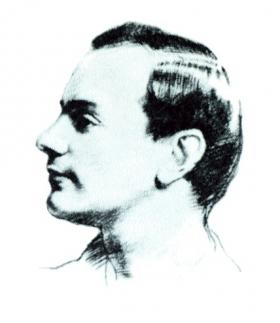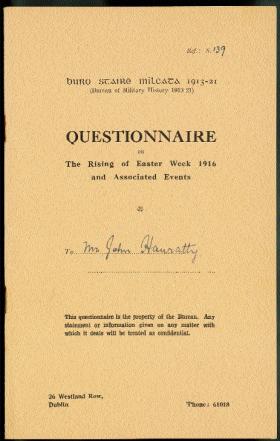Robert Emmet and 1916
Published in 18th–19th - Century History, 20th-century / Contemporary History, Features, Issue 3 (Autumn 2003), Revolutionary Period 1912-23, Robert Emmet, Volume 11
Pre-1916 interest in Emmet might be traced back to W.B. Yeats’s speech in America in 1904. (BBC Hulton Picture Library)
Among the various ‘ghosts’ invoked in the build-up to 1916 the name of Robert Emmet was central to the imagining of a ‘New Ireland’. As important was the influence of the Emmet family in America, where sympathy for the advanced nationalist cause in terms of both funds and propaganda was vital to any potential political outcome. After the founding of the Irish Volunteers (Oglaigh na hÉireann) in November 1913 there was a dearth of leadership and of men capable of training and drilling the swelling body of recruits. Stories of Emmet helped to fill this leadership vacuum. Emmet’s youth, his bold boundless initiative, his skill as a mathematician, his interest in military strategy, his oratory and, most significantly, his ‘sacrificial’ end were qualities used to inspire the martial imagination of another generation. Emmet’s sublimated image echoed in the heads of Irishmen destined to meet their end either on the battlefields of the Western Front, sacrificed for the defence of the British Empire, or in the GPO crossfire as ‘heroes’ for an imagined independent Irish nation.
Pre-1916 interest in Emmet might be conveniently traced back to W.B. Yeats’s speech in America in 1904. Thereafter other Irish-Irelanders such as Bulmer Hobson, Patrick Pearse, John Devoy, Seán MacDermot, Alice Green and Roger Casement all focused on Emmet’s memory and meaning for different purposes. In March 1914 and 1915, either side of the outbreak of the First World War, the advanced nationalists coordinated important commemoration rallies between Dublin and New York. Emmet became a mask behind which nationalist doctrines, political aspirations and republican ideals were openly discussed.
On his tour of America in 1914 Patrick Pearse used Emmet commemoration to deliver two high-voltage speeches linking ideas of patriotic sacrifice to matters of faith, as the revolutionary rhetoric shifted from words to action. ‘Heroes stand midway between God and men’, he prosaically proclaimed in an address delivered in the Academy of Music in Brooklyn on 2 March. Emmet was one such hero, who had left a ‘memory of sacrifice Christ-like in its perfection’. Pearse’s most powerful passage, linking landscape and memory, reconfigured the geography of Dublin around Emmet and the 1803 rebellion in a further bid to retrieve a sense of revolutionary purpose. After describing apocalyptic images of ‘cities levelled’ as the consequence of continued occupation of Ireland, he mapped a utopian past, present and future extending from his headmaster’s study in St Enda’s into an imagined day when the restless spirits were finally at peace.
I live in a place that is very full of heroic memories. In the room in which I work at St Enda’s College, Robert Emmet is said often to have sat; in our garden is a vine which they call the Emmet Vine and from which he is said to have plucked grapes; through our wood runs a path which is called Emmet’s walk—they say he and Sarah Curran walked there.
A week later, at the Aeolian Hall, Pearse attacked the notion of empire, condemning it as ‘the many-armed monster whose tentacles envelop us while its systems emit an inky fluid that shrouds its work of murder from the eyes of men’. Pearse transformed Emmet into the symbol of the patriotic leader and inscribed his body with the ideals of the ‘man of action’ possessed with ‘gentle and grave humanity’.
Dublin was equally astir with Emmet-mania. On 4 March a memorial concert was held in the Round Room of the Rotunda under the auspices of the Wolfe Tone and United Irishmen Memorial Association. This address was delivered by another young poet, Seán MacDermot (1884–1916). He sketched a more orthodox historical account of

Emmet had left ‘a memory of sacrifice Christ-like in its perfection’—Patrick Pearse. (National Museum of Ireland)
Emmet, impressively illustrated with a series of magic lantern and ‘limelight’ images, and made a vigorous defence of Emmet’s plot, defending it as a ‘well-laid plan’. The lecture-show then moved to a session of dancing and the singing of ballads and Irish airs, including Moore’s Oh! Breathe not his name. The evening concluded with a production of Yeats’s Caitlin Ní hUallachain performed by the Davis Players.
As spring rolled into summer, the world fragmented further. In the days after the successful landing of guns at Howth aboard the Asgard, Roger Casement wrote triumphantly to Alice Green from America on the success of the venture they had both helped mastermind: ‘The Irish here would make me into a Demi God if I let them. In Phila. [delphia] they have christened me, a deputation told me, “Robert Emmet”!’
A few days later the outbreak of the First World War only succeeded in fuelling Emmet’s flame. In the inaugural edition of Fianna (February 1915), Bulmer Hobson considered the birth of Emmet as one of the biggest years in the Fianna’s history and offered readers a special set of Emmet postcards. The following month Honesty, another mouthpiece of republicanism, edited by Seamus Upton (‘Gilbert Gilbraith’), ran a long eulogising poem on Emmet.
In March 1915, building on Pearse’s orations of the year before, a chain of Emmet celebrations were inaugurated across the United States. On 1 March Clan-na-Gael organised a 3000-strong gathering in the Academy of Music in Brooklyn. The keynote address was made by the former attorney general of the State of New York, Thomas Carmody. He chose the moment to deliver a scathing denunciation of the emerging Anglo-American alliance, making a specific attack on British foreign policy: ‘There will never be peace in this world until the foreign policy of England is broken and made to adjust itself to the proper interests of other nations’.
The following Sunday an even larger crowd, including many surviving Fenians from 1867, met at Aeolian Hall on West 43rd Street, braving a fierce snowstorm to hear the news of O’Donovan Rossa’s failing health. A long procession of speeches condemned John Redmond while openly advocating a German–Irish alliance. John Devoy’s Gaelic American was distributed (6 March 1916) and carried a transcript of Emmet’s Proclamation of the Provisional Government to the People of Ireland and his Speech from the Dock. It also included an illustrated anniversary Emmet supplement, a prosaic piece of hagiography highlighting the young rebel’s ‘passionate love of liberty’ and his ‘stainless’ private life while condemning English efforts to ‘blacken’ his character and ‘befoul his purposes’. The role of women in the months ahead was also carefully encoded into the stirring if stereotypical descriptions of both Anne Devlin and Sarah Curran.

The Bureau of Military History (HI 11.2, Summer 2003) interviewed IRA veterans about perceived links between 1803 and 1916. (Military Archives)
It is not hard to read the symbols of Emmet’s rising into the subtext of 1916. From the jointed pikes to the wording of the 1916 Proclamation itself, there are several examples of how 1803 and 1916 were linked across time and history. Most striking of all are the parallels, echoes and symmetries connecting Emmet’s and Casement’s speeches. Casement’s own life in defence of the dispossessed and his work in exposing international crimes against humanity had defined a specific position for Ireland in international relations and contributed mightily to helping Ireland take ‘her place among the nations of the earth’, while Emmet’s prophetic question, ‘Does the sentence of death which your unhallowed policy inflicts on my body, condemn my tongue to silence and my reputation to reproach?’, might as suitably be applied to Casement’s afterlife as to Emmet’s.
When the drafts for Casement’s Speech from the Dock were released among his prison papers into the Public Record Office in 1995 Emmet’s name featured prominently. In 1919 Marcus Garvey on the eve of the third anniversary of the execution of Casement made a reference: ‘The time has come for the negro race to offer up its martyrs upon the altar of liberty even as the Irish had given a long list from Robert Emmet to Roger Casement’. It is perhaps no wonder that when Oscar Traynor set up the Bureau of Military History among the questions formulated for veterans of the Rising was an inquiry as to how influential Emmet and the events of 1803 had been in the formulation of their own national ideas.
Angus Mitchell has recently published Casement (Haus, 2003).
















